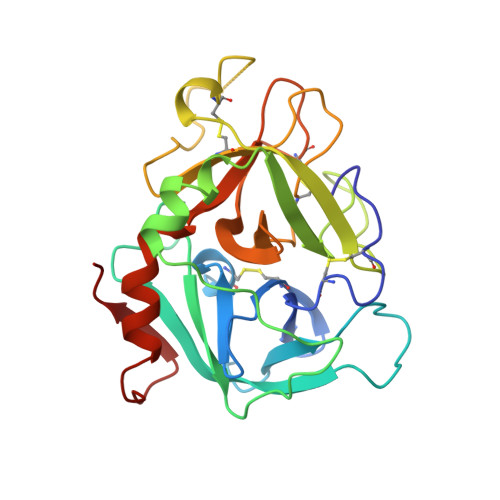Structure of human factor VIIa and its implications for the triggering of blood coagulation.
Pike, A.C., Brzozowski, A.M., Roberts, S.M., Olsen, O.H., Persson, E.(1999) Proc Natl Acad Sci U S A 96: 8925-8930
- PubMed: 10430872
- DOI: https://doi.org/10.1073/pnas.96.16.8925
- Primary Citation of Related Structures:
1QFK - PubMed Abstract:
Factor VIIa (EC 3.4.21.21) is a trypsin-like serine protease that plays a key role in the blood coagulation cascade. On injury, factor VIIa forms a complex with its allosteric regulator, tissue factor, and initiates blood clotting. Although the structure of the binary complex has already been determined [Banner, D. W., D'Arcy, A., Chène, C., Winkler, F. K., Guha, A., Konigsberg, W. H., Nemerson, Y. & Kirchhofer, D. (1996) Nature (London) 380, 41-46], the conformational effects of cofactor binding to factor VIIa are not known in detail because of a lack of structural information on free factor VIIa. Here we report the structure of gamma-carboxyglutamic acid-domainless human coagulation factor VIIa at a resolution of 2.8 A. The molecule adopts an extended conformation within the crystal similar to that previously observed for the full-length protein in complex with tissue factor. Detailed comparison of free and tissue factor-bound factor VIIa reveals several structural differences. The binding mode of the active-site inhibitor D-Phe-Phe-Arg methyl ketone differs in the two structures, suggesting a role for the cofactor in substrate recognition. More importantly, a surface-exposed alpha-helix in the protease domain (residues 307-312), which is located at the cofactor recognition site, is distorted in the free form of factor VIIa. This subtle structural difference sheds light on the mechanism of the dramatic tissue factor-induced enhancement of factor VIIa activity.
Organizational Affiliation:
Structural Biology Laboratory, Chemistry Department, University of York, York YO10 5DD, United Kingdom.




















